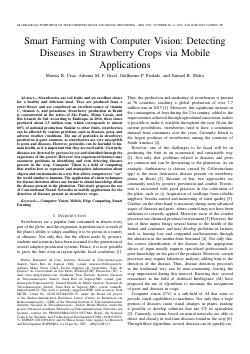
Smart Farming with Computer Vision: Detecting Diseases in Strawberry Crops via Mobile Applications
Mateus R Cruz, Guilherme Pires Pieadade, Adriana Maria Fuzer Grael, Samuel Mafra
DOI: 10.14209/sbrt.2023.1570923797
Evento: XLI Simpósio Brasileiro de Telecomunicações e Processamento de Sinais (SBrT2023)
Keywords: Computer Vision Mobile Edge Computing Smart Farming
Abstract
Strawberries are red fruits and an excellent choice for a healthy and delicious meal. They are produced from a sweet flower and are considered an excellent source of vitamin C, vitamin A, and potassium. Strawberry production in Brazil is concentrated in the states of São Paulo, Minas Gerais, and Rio Grande do Sul. According to Embrapa, in 2016, these states produced about 2.5 million tons, which corresponds to almost 60\% of national production. Similar to other fruits, strawberries can be affected by various problems, such as diseases, pests, and adverse weather conditions. The use of pesticides in strawberry production is quite common, as strawberries are very susceptible to pests and diseases. However, pesticides can be harmful to human health, so it is important that they are used safely. Currently, diseases are detected by growers by eye and identified through the experience of the grower. However, less experienced farmers may encounter problems in identifying and even detecting diseases present in the crop. Computer Vision is a field of computing that studies how to represent and manipulate information about objects and environments in a way that allows computers to "see" the world similar to humans. The application of vision techniques for disease detection allows any farmer to obtain knowledge about the disease present in the plantation. This study proposes the use of Convolutional Neural Networks in mobile applications for the detection of diseases present in strawberry crops.Download